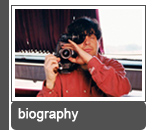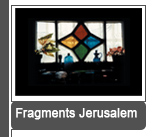
 |
 |
 |
 |
Selected reviews
This film is a very personal account of a journey across South America, during which the director and his wife visit places, which they photographed 30 years ago. It is not only a road movie, but also a journey in time – to the time of their youth and their youthful emotions and dreams. It’s a very wise and deep film. I didn’t feel that it was four hours long and once it finished I didn’t feel like watching any feature films, which, in comparison with this film seemed meaningless.
The filmmaker's honeymoon trip in 1970 led him and his wife Jacqueline, complete with backpack and camera, all through the Bolivian Andes. On their way they discovered the old silver mining city of the Incas, Potosi, once one of the biggest and most prosperous cities in the world. Three decades later they go back there again with a film camera and their three daughters. The film documents this journey, putting the footage in relation to the photographs taken during the first trip. Memory and the present overlap,creating an impressive reflection on generations and the effects of time.
Ron Havilio is a master of composing these pieces of memory and the present. Because of the use of the photos from the 1970 trip and the photo and film material from the recent trip, Potosi, le temps du voyage is not simply a travel film. It does indeed relate a great deal of information about the rise and fall of the city of Potosi, but it also sheds light on the inner workings of the director's own Israeli family. Havilio exposes the stories behind the images, and his method lets us look deep into a reality marked by the living conditions of the viewer.
This film not only reveals complex family dynamics but also reframes the responsibility of documentarists toward their subjects. The process of preserving memory in images becomes a process of preserving the family.
"Potosi” is not a documentary about the work of the miners. Neither is it a political manifesto against the poverty in Bolivia and the capitalist world order, and definitely not a National Geographic-style exotic-ethnographic story. The diary of the journey through the Andes is a quiet film about sorting out the past and the rebuilding of the family. It is worth seeing not only because of the unpretentious photographs – images of faces, architectural details, mountain landscapes – but most of all to contemplate the phenomenon of vanishing and the passing time. Four hours (with a short break) pass like a beat.
Potosi, le temps du voyage is a family's journey across South America, recreating the parents honeymoon odyssey 29 years before. In Bolivia,they discover Potosi and its once enormous silver mines: a forgotten city at an altitude of 4100 meters that used to be a magnificent place and a living hell for the miners.
A travelogue with a home movie flavour, the film paints a touching portrait of Potosi and its inhabitants. Highly structured and remarkably edited, the sequences are intercalated with photos taken in 1970. Like silent fragments of the past, they reveal two aspects of the city and question the ideas of memory and transmission.
The border between past and present becomes vague, and the created rift encourages reflection over what is most important in life. The journey of the Havilio family, is the denial of traditional tourism. What interest them, is not the landscape nor exotism, but the human being.
/…../ Traveling with Ron Havilio is a lesson in observation, a gaze which crosses the barriers of space, memory and time – as well as the darkness of a cinema hall – and leads us directly to brightness.
Another absorbing, long film that stood out was Ron Havilio’s Potosi, the Journey. Like his earlier Fragments - Jerusalem, the film combines the history and politics of the Bolivian city with Havilio’s own personal connection to the place. Potosi, a silver mining town high in the Andes, was one of the wealthiest and largest Spanish Colonial cities in its heyday. After the boom years, the remote city fell into poverty and has been largely forgotten. Havilio and his wife, both avid photographers and committed leftists, spent their honeymoon exploring and photographing the town. The film chronicles his return to Potosi with his wife and three adult daughters many years later. Havilio documents the folk traditions and people along the way, as he narrates the long decline of the town alongside the family’s odyssey. Havilio returns to the town out of nostalgia as well as a desire to see the place that stirred his Marxist ideals and inspired the photographs of misery that he and his wife took. On his return, as a middle-aged father, he sees with different eyes and questions the objective realism of the documents he made years ago.
Potosi: a journey to the source of time. (published originally in Polish, in “Gazeta Wyborcza”)
A beautiful, wise and sincere story about returns. Over-four-hours-long-film “Potosi: the Journey” seduces us with its slow narration, and a combination of beautiful black-white photos from 1970 and contemporary ones.
Ron and Jacqueline arrive in Potosi – the highest located city in the world – after 30 years. On their last trip they were 20 years old. This time they take their daughters, Naomi, Noa and Yael, with them. The journey becomes an experience, on which they rebuild their family relations. Grown up girls help their father to shoot the film, although Potosi itself is not important for them. They think that their parents, especially their father, attach too much weight to it. – You shouldn’t look in Potosi but in yourself – says one of the daughters.
Ron and Jacqueline look back at their relationship. Distancing themselves from the everyday life in Israel makes them understand the reasons for the inner sadness, which has been present in their relationship for a long time. For her, it’s the traumatic memories of Shoah experienced by her family – polish Jews who emigrated to Argentina. He discovers that the feelings of insecurity and fear were caused by his father’s work as an agent of Mossad.
The main characters of the film, though, is Potosi and its citizens. Established by the Spaniards, the mining city in the Andes used to supply the Spanish Empire with silver. Indian and African workers worked there in inhumane conditions. Nowadays, the Indians working the zinc mines still suffer from poverty and often die of lung diseases. Havilio and his daughters go down into the mines to film mineros and to show the blue-eyed Tio, the god-protector of those who work deep down. His camera also accompanies a workers’ demonstration and films interviews with the locals. The travelers show them photos from their first excursion and together they look for the portrayed people. Most of them have already died but they manage to find a woman who used to run a shoe shop and participants of a miner’s funeral. They tell their stories and, although these are not happy one, they seem to have submitted to their fate. Even the kids from the local kindergarten know how their lives will look like. With their delicate voices they sing about a miner who would work hard for no pay until he dies.
This sadness of Potosi can also be seen on Ron’s old photos. Even the Indian music that they heard back then seemed plaintive and sorrowful to them. But it’s not the real image of the city, merely a feeling that tormented the young Havilios 30 years ago. That is the truth that Ron discovers at the end of the journey.
“Potosi” is not a documentary about the work of the miners. Neither is it a political manifesto against the poverty in Bolivia and the capitalist world order, and definitely not a National Geographic-style exotic-ethnographic story. The diary of the journey through the Andes is a quiet film about sorting out the past and the rebuilding of the family. It is worth seeing not only because of the unpretentious photographs – images of faces, architectural details, mountain landscapes – but most of all to contemplate the phenomenon of vanishing and the passing time. Four hours (with a short break) pass like a beat.
More reviews in the French and Spanish sections of the site.
and in Portuguese:
O retorno a um passado cintilante
Em uma das cenas iniciais de Potosi, a Jornada, o diretor israelense Ron Havilio ouve em uma conversa familiar o conselho de não voltar à cidade boliviana que conheceu nos anos 70 e que dá título ao filme. “Mantenha as impressões de sua memória e das fotografias que você e sua mulher fizeram, pois as coisas mudaram muito”, justifica uma amiga da família. Naquela altura, no entanto, Havilio e sua mulher Jacqueline já estavam determinados a desafiar as lembranças guardadas por trinta anos da viagem realizada pelos Andes, especialmente as relacionadas a Potosi. No caminho até Cuzco, no Peru, saídos de Buenos Aires, onde se casaram, os dois depararam com a cidade hoje esquecida, mas muito rica e importante no século XVII por causa da prata extraída de suas montanhas pelos indígenas. A visão foi impactante para o casal e a vontade de voltar persistiu, até que finalmente ganhou forma há alguns anos com o projeto de um documentário que uniria passado e presente, inclusive no que diz respeito à família de Havilio. Ele e a mulher retornaram à cidade da prata, agora acompanhados das três filhas e de uma câmera de filmar, em vez de uma máquina fotográfica.
O resultado, mais do que um filme, é uma obra maior em que convergem a memória pessoal e afetiva do diretor e de sua mulher – comentada por ambos e visualizada nas fotografias em preto-e-branco –, a história cultural de um povo e o reflexo desses componentes na atual configuração da família protagonista. A intenção fica clara nas duas partes que somam quatro horas de filme: a primeira é dedicada ao percurso da viagem propriamente dita, e a seguinte, voltada aos personagens que a atravessaram. “A diferença é que no primeiro bloco há uma confluência da nossa história familiar e da primeira viagem a Potosi com a visão de novos membros da minha família, no caso minhas filhas; já a segunda parte estende um olhar mais intimista, que busca hoje os personagens que conhecemos no passado”, explica Havilio em entrevista para a Mostra. “A viagem também foi uma oportunidade para que todos nós, eu, minha mulher e minhas filhas, ficássemos juntos novamente, partilhássemos de um tempo em comum, o que há muito não acontecia”.
Para o espectador, a empreitada dos Havilio chega como um diário de viagem em forma cronológica, a partir do momento em que a família de Jacqueline se radicou em Buenos Aires, a mudança dela para Israel, o casamento na capital argentina e então a viagem. A câmera de Havilio flagra as várias etapas do retorno à Argentina e o encontro com familiares, as opiniões e observações dos envolvidos, enquanto as antigas fotografias contextualizam o objetivo maior do documentário. Esse procedimento de Havilio, que muitas vezes deixa a câmera aberta num cenário íntimo colhendo comentários, gestos e situações rotineiras de sua família, tem influência direta do também realizador independente David Perlov (1930-2003).
Perlov, nascido no Rio de Janeiro e criado em São Paulo, realizou em vários momentos de sua trajetória – também em Paris e Israel – um projeto batizado Diários. Foram seis filmes rodados ao longo de dez anos e exibidos na 30ª Mostra. Perlov foi professor de Havilio na faculdade de cinema. “Ele foi uma figura extremamente importante para mim. Ensinou-me que é possível realizar um filme estritamente pessoal, sem se importar com tendências, mercado ou glamour”, lembra Havilio. “O cinema dele revela que é possível expressar na tela uma vida em particular, os sentimentos pessoais, uma história só sua, e ainda assim fazer tudo isso interessante aos outros. E essa é uma opção difícil e perigosa, na qual ele se saía muito bem”.
Havilio reconhece sua dívida com os ensinamentos de Perlov, mas aponta algumas diferenças entre seu estilo e o de seu mestre: “Perlov improvisava mais, seu cinema é o da espontaneidade; o meu cinema é mais organizado, estruturado, não conto com o acaso”. O diretor também acredita que seus filmes – realizou os documentários Diary e Fragments Jerusalem, saga de uma década sobre a cidade em que nasceu – propõem um conflito que não há no cinema de Perlov: “Procuro mostrar um embate entre caos e realidade, sempre a partir do ponto de vista pessoal, o mais próximo possível do individual”. Havilio exemplifica com uma das passagens mais significativas do documentário, quando ele e sua filha descem ao interior de uma mina e passam a conversar com os mineiros, tanto homens que trabalham ali há quatro décadas quanto jovens de 14 anos e há sete no ofício: “Enquanto eles estão completamente habituados, nós fomos ficando aos poucos incomodados de estar naquele lugar fechado e sufocante; pode-se ouvir minha filha pedindo para sair dali”.
A mesma atenção dada a um personagem ou situação específica na mina é vista em outros momentos do filme, especialmente quando Havilio flagra as festas locais ou parte em busca de algum personagem que fotografou na viagem anterior. “O que me interessa é colher um fragmento do cotidiano; é isso que fizeram os pintores (Johannes) Vermeer e (Jean-Baptiste-Siméon) Chardin, por exemplo, de quem vocês aqui em São Paulo têm telas maravilhosas no MASP”, disse, referindo-se ao artista holandês e francês, respectivamente. No primeiro bloco do filme, o realizador não encontra as pessoas da foto. Mas no segundo, com uma procura mais acurada e vagarosa, ele descobre, por exemplo, uma senhora que foi registrada ainda jovem num enterro. “Isso me interessa também, trabalhar com muitos tempos; é outro fator que me distancia de Perlov, que se fixa no presente”, diz. E complementa: “Esses personagens que eu reencontro no filme representam o momento em que os tempos se tocam”. Equilíbrio que o cineasta também traz à tona quando aproxima a cidade, que um dia já foi rica, da pobreza atual: “É a relação norte-sul, no sentido metafórico, que rege boa parte de nosso mundo. Se você quiser uma representação do que foi a destruição pela ocupação espanhola é só ir a Potosi”.
Atualmente, Havilio está trabalhando em uma terceira parte do filme, que registra o que aconteceu depois dessa aventura em Potosi. “É uma situação em dois eixos: de um lado, estávamos eu e minha mulher, que veio de Israel, numa temporada em Paris para fazer a montagem do filme; de outro, voltei à Bolívia para buscar minha filha Yael, que havia permanecido lá por um ano; essa condição de estarmos fora de nossa terra me fez pensar sobre o exílio e é sobre isso a parte final do projeto”, explicou.
Orlando Margarido, Jornal da Mostra, 540, 28.10.2007
31 Mostra internacional de cinema, São Paulo International Film
Piotr Bogalecki review (in Polish) pdf